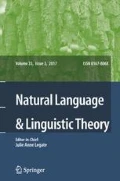Abstract
This paper deals with the so-called Person Case Constraint (Bonet, E. 1991), a universal constraint blocking accusative clitics and object agreement morphemes other than third person when a dative is inserted in the same clitic/agreement cluster. The aim of this paper is twofold. First, we argue that the scope of the PCC is considerably broader than assumed in previous work, and that neither its formulation in terms of person (1st/2nd vs. 3rd)-case (accusative vs. dative) restrictions nor its morphological nature are part of the right descriptive generalization. We present evidence (i) that the PCC is triggered by the presence of an animacy feature in the object’s agreement set; (ii) that it is not case dependent, also showing up in languages that lack dative case; and (iii) that it is not morphologically bound. Second, we argue that the PCC, even if it is modified accordingly, still puts together two different properties of the agreement system that should be set apart: (i) a cross-linguistic sensitivity of object agreement to animacy and (ii) a similarly widespread restriction on multiple object agreement observed crosslinguistically. These properties lead us to propose a new generalization, the Object Agreement Constraint (OAC): if the verbal complex encodes object agreement, no other argument can be licensed through verbal agreement.
Similar content being viewed by others
References
Adger, D., & Harbour, D. (2004). The syntax and syncretisms of the person case constraint to appear in MITWPL.
Albizu P. (1997a). Generalized person-case constraint: A case for a syntax-driven inflectional morphology. In: Mendikoetxea A., Uribe-Etxebarria M. (eds) Theoretical issues on the morphology-syntax interface, Supplements of the Anuario del Seminario Julio de Urquijo # 40. San Sebastián, Diputación Foral de Guipúzcoa, pp. 1–34
Albizu, P. (1997b). The syntax of person agreement. Unpublished Ph.D. dissertation, University of Southern California, Los Angeles.
Albizu P. (2002). Datibo sintagmen izaera sintaktikoaren inguruan: Eztabaidarako oinarrizko zenbait datu. In: Fernández B., Albizu P. (eds) Kasu eta komunztaduraren gainean/On Case and Agreement. Bilbao, University of the Basque Country Publications, pp. 9–70
Anagnostopoulou, E. (1999). Dative argument and clitic doubling. ms., MIT.
Anagnostopoulou E. (2002). The syntax of ditransitives: Evidence from clitics. Berlin, Mouton de Gruyter
Arregi, E. (2003a). Dative alternations in basque. ms., University of the Basque Country (UPV-EHU).
Arregi, E. (2003b). Possessor dative constructions in Basque must be derived. ms., University of the Basque Country (UPV-EHU).
Baker M. (1988). Incorporation. Chicago, Chicago University Press
Baker M. (1996). The polysynthesis parameter. Oxford, Oxford University Press
Barss A., Lasnik H. (1986). A note on anaphora and double objects. Linguistic Inquiry, 17, 347–353
Bejar, S., & Rezac, M. (2006). Cyclic agree and the derivation of PCC effects. (to appear) In A. T. Pérez-Leroux, & Y. Roberge (Eds.), Selected papers from LSRL XXXII. Philadelphia: John Benjamins.
Blake B. (1987). Australian aboriginal grammar. Camberra, Croom Helm
Bleam, T. M. (2000). Leísta Spanish and the syntax of clitic doubling. Unpublished Ph.D. dissertation, University of Delaware.
Boeckx C. (2000). Quirky agreement. Studia Linguistica, 54, 354–380
Boeckx C. (2004). Long distance agreement in Hindi: Theoretical implications. Studia Linguistica, 58, 23–43
Bonet, E. (1991). Morphology after syntax: Pronominal clitics in Romance. Unpublished Ph.D. dissertation, MIT, Cambridge, MA, USA.
Borer H., Grodzinsky Y. (1986). Syntactic cliticization and lexical cliticization: The case of Hebrew dative clitics. In: Borer H. (eds) Syntax and semantics, Vol. 19. New York, Academic Press, pp. 175–215
Bresnan J., Moshi L. (1990). Object asymmetries in comparative Bantu syntax. Linguistic Inquiry, 21, 147–185
Brugè L., Brugger G. (1996). On the accusative a in Spanish. Probus, 8, 1–51
Chomsky N. (1995). The minimalist program. Cambridge, MA, MIT Press
Chomsky N. (2000). Minimalist inquiries: The framework. In: Martin R. et al. (eds) Step by step: Papers in honour of Howard Lasnik. Cambridge, MA, MIT Press, pp. 289–155
Chomsky N. (2001). Derivation by phase. In: Kenstowicz M. (eds) Ken Hale: A life in language. Cambridge, MA, MIT Press, pp. 1–52
Dowty D. (1991). Thematic Proto-roles and argument selection. Language, 67, 547–617
Dryer M.S. (1986). Primary objects, secondary objects, and antidative. Language, 62, 808–845
Evans N. (1997). Role or Cast? Noun incorporation and complex Predicates in Mayali. In: Alsina A. et al. (eds) Complex predicates. Stanford, CSLI, pp. 397–430
Fernández-Ordóñez, I. (1999). Leísmo, laímo y loísmo. In I. Bosque, & V. Demonte (Eds.), Gramática descriptiva de la lengua española (pp. 1317–1397). Madrid: Espasa Calpe.
Fernández Soriano, O. (1989). Rección y ligamiento en español: aspectos del parámetro del sujeto nulo. Unpublished Ph.D. Dissertation, Universidad Autónoma de Madrid.
Franco, J. (1993). On object agreement in Spanish. Unpublished Ph.D. dissertation, University of Southern California, Los Angeles.
Hale K. (1973). Person marking in Walbiri. In: Anderson S., Kiparsky P. (eds) A Festschrift for Morris Halle. New York, Holt, Reinhart and Winston, pp. 308–344
Hanson, R. (2000). Pronoun acquisition and the morphological feature geometry. In S. Atkey, J. Carson, & M. Dobrovolsky. (Eds.), Calgary working papers in linguistics (Vol. 22, pp. 1–4). Calgary.
Harley H., Ritter E. (2002). Structuring the bundle: A universal morphosyntactic feature geometry. In: Simon H., Weise H. (eds) Pronouns: Features and representation. Amsterdam, John Benjamins, pp. 23–39
Harris A.C. (1981). Georgian Syntax: A study in relational grammar. Cambridge, Cambridge University Press
Haspelmath, M. (2001). Explaining the ditransitive person-role constraint: A usage-based approach. ms., Max-Planck-Institut für evolutionäre Anthropologie.
Hualde J.I. (1989). Double object constructions in KiRimi. In: Newman P., Botne R. (eds) Current approaches to African linguistics Vol. 5. Dordrecht, Foris
Huang J. (1984). On the distribution and reference of empty pronouns. Linguistic Inquiry, 15, 531–574
de Jong, J. J. (1996). The case of bound pronouns in peripherial Romance. Groningen Dissertations in Linguistics, Groningen.
Koizumi, M. (1995). Phrase structure in Minimalist syntax. Unpublished Ph.D. dissertation, MIT, Cambridge, MA.
Laka I. (1993). The structure of inflection: A case study in X0-syntax. In: Hualde J.I., Ortiz de Urbina J.(eds) Generative studies in Basque linguistics. Amsterdam & Philadelphia, John Benjamins, pp. 21–70
Landa, A. (1995). Conditions on null objects in Basque Spanish and their relation to Leísmo and clitic doubling. Unpublished Ph.D. dissertation, University of Southern California, Los Angeles.
Larson, M. (2002). The semantics of object drop in Baule. In M. Nissim (Ed.), Proceedings of the 7th ESSLLI Student Session (pp. 1–10).
Leonetti M. (2004). Specificity and differential object marking in Spanish. Catalan Journal of Linguistics, 3, 75–114
Masullo, P. (1992). Incorporation and Case theory in Spanish: A crosslinguistic perspective. Unpublished Ph.D. dissertation, University of Washington, Seattle.
Mithun M. (1984). The evolution of noun incorporation. Language, 60, 847–94
Ormazabal J. (2000). A conspiracy theory of case and agreement. In: Martin R. et al. (eds) Step by step: Papers in honor of Howard Lasnik. Cambridge, MA, MIT Press, pp. 235–260
Ormazabal, J., & Romero, J. (1998a). Attract-F: A case against case. Paper presented at the 21st GLOW Conference, Tilburg.
Ormazabal J., Romero J. (1998b). On the syntactic nature of the me-lui and the Person-Case Constraint. Anuario del Seminario Julio de Urquijo, 32, 415–434
Ormazabal, J. & Romero, J. (2002). Agreement restrictions. ms., University of the Basque Country (EHU)/Basque Center for Language Research (LEHIA) and University of Alcalá/U. Autónoma de Madrid.
Ormazabal J., Romero J. (2003). Komunztadura, hiru ikuspegi (II): Absolutibo komuntadurarik eza. In: Gorrotxategi J. (eds) Basque and (Paleo)Hispanic studies. In the wake of Michelena’s work. Bilbao, University of the Basque Country Publications, pp. 315–332
Ormazabal, J. & Romero, J. (2004). Clitics and agreement. In O. Crouzet (Ed.), Proceedings of the III Journées d’Études Linguistiques de Nantes (JEL’2004). University of Nantes.
Ormazabal, J., & Romero, J. (2006). Object clitics, determiners, and agreement. ms., University of the Basque Country/Hitt, University of Extremadura.
Pensado C. (1995). El complemento directo preposicional. Visor, Madrid
Perlmutter D. (1971). Deep and surface structure constraints in syntax. New York, Rinehart & Winston Inc
Reinhart T., Reuland E. (1993). Reflexivity. Linguistic Inquiry, 24, 657–720
Rezac M. (2003). The fine structure of cyclic agree. Syntax, 6, 156–182
Rezac, M. (2004). Elements of cyclic syntax: Agree and merge. Unpublished Ph.D. dissertation, University of Toronto.
Rivero M.L., Sheppard M.M. (2003). Indefinite reflexive Clitics in Slavic: Polish and Slovenian. Natural Language and Linguistic Theory, 21, 89–155
Roca, F. (1992). On the licensing of pronominal clitics: The properties of object clitics in Spanish and Catalan. MA thesis, Universitat Autònoma de Barcelona.
Roca F. (1996). Morfemas objetivos y determinantes: los clíticos del español. Verba, 23, 83–119
Romero, J. (1997). Construcciones de doble objeto y gramática universal. Unpublished Ph.D. dissertation, Universidad Autónoma de Madrid.
Romero, J. (1999). The case of agreement. In K. Arregui, B. Bruening, & V. Lin (Eds.), Papers on syntax and morphology(MITWPL 33) (pp. 343–368). Cambridge, MA.
Romero J. (2001a). A note on Case (mis)-match in Spanish. Cuadernos de Lingüística del I.U. Ortega y Gasset, 8, 97–104
Romero, J. (2001b). On the representational nature of case. ms., U. Autónoma de Madrid/U. de Alcalá de Henares.
Rude N. (1986). Topicality, transitivity and the direct object in Nez Perce. International Journal of American Linguistics, 52, 124–153
Saah, K. K. (1992). Null object construction in akan. In C. Collins, & V. Manfredi (Eds.), Proceedings of the Kwa comparative syntax workshop, MITWPL (Vol. 17, pp. 219–244).
Silverstein, M. (1976). Hierarchy of features and ergativity. In R. M. W. Dixon (Ed.), Grammatical categories in Australian languages (pp. 112–171). Canberra: Australian Institute of Aboriginal Studies. [Reprinted in P. Muysken, & H. van Riemsdijk. (1986). Features and projections, Foris, Dordrecht, pp. 163–232.]
Suñer M. (1988). The role of agreement in clitic-doubled constructions. Natural Language and Linguistic Theory, 6, 391–434
Torrego E. (1998). The dependencies of objects. Cambridge, MA, MIT Press
Uriagereka, J. (1988). On Government. Unpublished Ph.D. dissertation, University of Connecticut, Storrs.
Uriagereka J. (1995). Aspects of the syntax of clitic placement in Western Romance. Linguistic Inquiry, 26, 79–124
Uriagereka J. (1996). Warps: some thoughts on categorization. Cuadernos de Lingüística de IU. Ortega y Gasset, 4, 1–38
Woolford E. (2000). Agreement in disguise. In: Carstens V., Parkinson F. (eds) Advances in African linguistics. Trenton, Africa World Press, pp. 103–117
Wurm S.A. (1976). Accusative marking in Duudidjawu (Waga-waga). In: Dixon R.M.W. (eds) Grammatical categories in Australian languages. Canberra, Australian Institute of Aboriginal Languages, pp. 106–111
Author information
Authors and Affiliations
Corresponding author
Rights and permissions
About this article
Cite this article
Ormazabal, J., Romero, J. The Object Agreement Constraint. Nat Language Linguistic Theory 25, 315–347 (2007). https://doi.org/10.1007/s11049-006-9010-9
Accepted:
Published:
Issue Date:
DOI: https://doi.org/10.1007/s11049-006-9010-9




